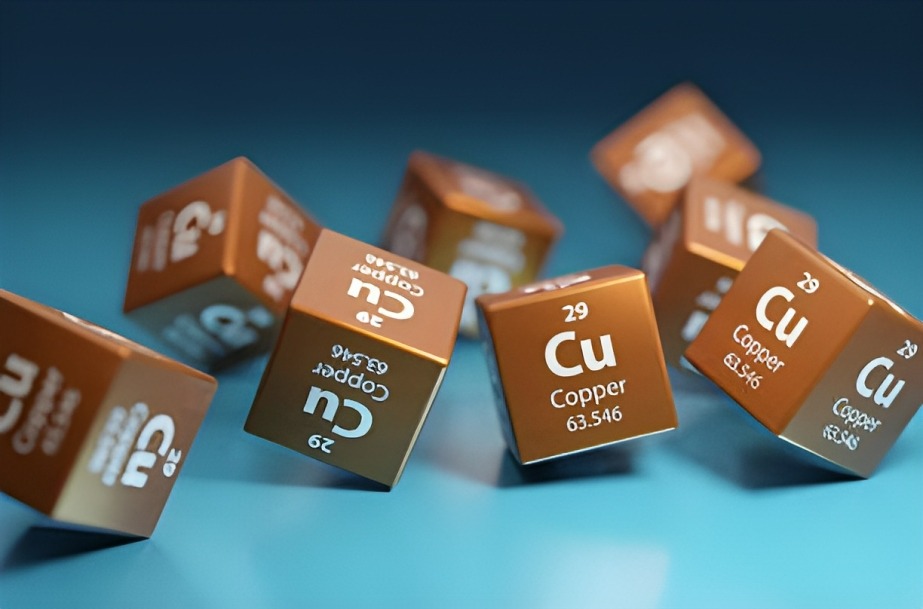In the world of materials science, copper occupies a position of unique importance. Its history, utility, and versatility span millennia, dating back to ancient civilizations that first harnessed its potential. Copper has played a vital role in human progress, from early tools and decorative artifacts to its extensive use in modern electrical systems and architectural marvels.
But what makes copper truly intriguing, apart from its rich historical tapestry, is its density. Density is a fundamental property that often goes unnoticed, yet it underpins copper’s remarkable characteristics and its diverse applications across various industries.
What Is The Density Of Copper?
The density of copper is approximately 8.96 grams per cubic centimeter (g/cm³) at room temperature. This value signifies that a single cubic centimeter of copper weighs 8.96 grams. Such density places copper among the heaviest elemental metals, surpassing materials like aluminum and titanium.
Copper’s relatively high density is a result of its atomic structure. Each copper atom is densely packed in a crystalline lattice, contributing to the metal’s overall density. This inherent density grants copper several remarkable properties, such as exceptional electrical conductivity and malleability.
This blog aims to unravel the mysteries surrounding the density of copper. By understanding this property, we gain a deeper appreciation for copper’s role in various applications, from electrical wiring to artistic endeavors. We will delve into the science behind copper’s density, highlighting its importance in both scientific and practical contexts, shedding light on why this unassuming property matters more than we might realize.
What Is Density?
Density, in scientific terms, represents a fundamental physical property that characterizes how much mass is concentrated within a given volume. It’s a key parameter in materials science and physics, providing insights into a material’s composition and behavior.
The formula for density is simple yet profound:
Density (ρ) = Mass (m) / Volume (V).
Density is typically expressed in units such as grams per cubic centimeter (g/cm³) or kilograms per cubic meter (kg/m³), depending on the scale of measurement.
The importance of density cannot be overstated. It serves as a fundamental property for distinguishing and classifying materials. For example, the density of copper, which is approximately 8.96 g/cm³, is significantly higher than that of aluminum, which is around 2.70 g/cm³. This difference in density is a critical factor in materials selection for various applications.
In the context of copper and its alloys, understanding density is vital for engineers, scientists, and copper alloy suppliers alike. It guides decisions regarding material choices for specific applications, ensuring that the selected material meets the requirements for strength, weight, and other performance criteria. Density also plays a pivotal role in designing products where space and weight considerations are paramount, such as aircraft components and electrical wiring.
Units of Measurement for Density
In the realm of scientific inquiry and engineering, precise measurement is paramount. Density, a fundamental property, is no exception. Density can be expressed in several units of measurement, each chosen for specific applications or convenience in calculations. For copper and its alloys, understanding these units is essential for scientists, engineers, and copper alloy suppliers as they navigate the intricacies of material properties.
Grams per Cubic Centimeter (g/cm³)
This unit is one of the most commonly used for density. It expresses mass in grams (g) per unit volume in cubic centimeters (cm³). For example, the density of copper is approximately 8.96 g/cm³, signifying that a cubic centimeter of copper weighs 8.96 grams.
Kilograms per Cubic Meter (kg/m³)
In scientific research and larger-scale industrial applications, density is often expressed in kilograms (kg) per cubic meter (m³). To convert from g/cm³ to kg/m³, one can multiply by 1000. So, the density of copper becomes approximately 8960 kg/m³.
Pounds per Cubic Inch (lb/in³)
In some engineering contexts, especially in the United States, density is measured in pounds (lb) per cubic inch (in³). To convert from g/cm³ to lb/in³, one can use a conversion factor of approximately 0.0361. This yields a density for copper of about 0.322 lb/in³.
Each of these units offers advantages based on the scale of the application. While g/cm³ is convenient for laboratory work, kg/m³ is favored in industrial settings due to the larger volumes typically encountered. The choice of units depends on the specific requirements of the task at hand, with density serving as a crucial parameter for scientists, engineers, and copper alloy suppliers alike in ensuring optimal material selection and performance.
Copper's Atomic Structure

To truly grasp the density of copper, we must journey to its atomic core. In this section, we’ll embark on an exploration of copper’s atomic structure, peering into the intricate arrangement of its fundamental building blocks: atoms. By delving into the inner workings of copper at the atomic level, we can unearth the secrets behind its remarkable properties, including its density.
Copper's Atomic Structure
Copper’s atomic structure is an intricate dance of electrons, protons, and neutrons orchestrated on a minuscule scale. At its heart lies a nucleus composed of protons (positively charged) and neutrons (neutral), tightly bound together. Encircling this nucleus, electrons (negatively charged) move in well-defined energy levels or electron shells.
Copper’s atomic number, 29, signifies that it has 29 electrons. These electrons are distributed across its electron shells as follows: 2 in the first shell, 8 in the second shell, and 18 in the third shell. The arrangement adheres to the principles of electron configuration, following a pattern of 2-8-18-1. This lone electron in the outermost shell plays a pivotal role in copper’s electrical conductivity.
How Atomic Arrangement Relates to Density?
The relationship between copper’s atomic arrangement and its density lies in the packing of these atoms within a given volume. The densely packed atomic structure of copper contributes significantly to its relatively high density of approximately 8.96 g/cm³.
The more closely packed the atoms are within a material, the higher its density. In copper, the atoms are arranged in a crystalline lattice, with strong metallic bonds that keep them close together. This compact atomic structure results in a high mass per unit volume, which, in turn, gives copper its notable density.
Understanding copper’s atomic structure is essential for scientists, engineers, and copper alloy suppliers. It elucidates the material’s exceptional properties, such as high electrical conductivity, and sheds light on its density, a critical factor in various industrial applications.
How To Measure Copper's Density?
In our quest to comprehend copper’s density, we must navigate the realm of measurement and precision. This section delves into the techniques and methodologies employed to determine the density of copper with accuracy. Just as copper plays a pivotal role in numerous industries, the precise measurement of its density is equally vital, guiding engineers, scientists, and copper alloy suppliers in material selection and design.
Methods and instruments used to determine copper's density
The accurate determination of copper’s density requires meticulous measurement techniques and precise instruments. These methods are crucial for scientists, engineers, and copper alloy suppliers as they strive to understand and work with this essential material. Here, we delve into the scientific procedures and instruments utilized to unveil the density of copper.
Water Displacement Method
One of the simplest yet effective methods involves immersing a copper sample in water and measuring the change in water level. The increase in water level corresponds to the volume of copper displaced. Dividing the mass of the copper by this volume yields the density.
Archimedes' Principle
This principle, dating back to ancient Greece, relies on the buoyant force experienced by a submerged object. By measuring the weight of the copper in both air and water, one can precisely determine its volume and, consequently, its density.
Pycnometers
These specialized containers have a precisely known volume. By filling a pycnometer with copper and measuring its weight, the density can be calculated with high accuracy.
X-ray Crystallography
In advanced scientific research, X-ray crystallography can reveal the atomic arrangement within copper crystals. This data can indirectly aid in determining copper's density by providing insights into its atomic structure.
Micrometer Calipers and Balances
For small, solid copper objects, micrometer calipers can measure dimensions with exceptional precision. When combined with precise balances, the density can be calculated by dividing the mass by the volume.
Density Gradient Columns
In laboratories, density gradient columns use solutions of known densities to compare with the density of a copper sample. This method is particularly useful for irregularly shaped objects.
These methods, along with specialized instruments and techniques, empower scientists and engineers to measure the density of copper with remarkable accuracy. The resulting data not only enhances our understanding of copper’s fundamental properties but also guides its application in a myriad of industries, from electrical engineering to architecture.
What is the significance of accurate density measurement?
Precise density measurements of copper are not merely a scientific exercise; they hold profound importance in various domains, influencing industries and innovations worldwide. Understanding why accurate density measurements matter is pivotal for scientists, engineers, and copper alloy suppliers alike.
Material Characterization
Accurate density values are fundamental for characterizing materials like copper. These measurements help establish a material's identity, ensuring it meets specific requirements for a given application. Copper alloy suppliers rely on precise density data to confirm the composition and quality of their products.
Quality Control
In industries where copper and its alloys are extensively used, such as construction and electronics, quality control is paramount. Accurate density measurements serve as a quality assurance tool, allowing manufacturers to verify that the copper materials meet predefined standards.
Design and Engineering
Engineers and designers depend on copper's density data to make informed decisions when selecting materials for various applications. Whether it's designing lightweight electrical components or heavy-duty structural elements, understanding copper's density aids in achieving optimal performance and efficiency.
Material Selection
Accurate density values enable material scientists to choose the right materials for specific applications. In fields like aerospace, where weight is a critical factor, knowing copper's density is indispensable for selecting materials that meet both performance and weight requirements.
Precision Manufacturing
For manufacturers producing components or products using copper, precise density measurements are essential for determining the volume and mass of raw materials required. This, in turn, minimizes waste and optimizes production processes.
Research and Development
In scientific research and development, understanding copper's density aids in formulating theories, designing experiments, and predicting material behaviors. Accurate density data contribute to advancements in materials science.
Safety and Compliance
In sectors like plumbing and healthcare, copper's density measurements are vital for ensuring safety and compliance with regulations. Incorrect material choices could lead to system failures or health hazards.
In essence, accurate density measurements of copper are a linchpin of quality, precision, and innovation across various industries. They underpin material selection, product design, and manufacturing processes, ultimately shaping the performance and reliability of products we encounter daily. These measurements are not mere numbers but the foundation upon which countless applications and technologies are built.
Comparing copper's density to other materials
Comparing copper’s density to that of other materials is a valuable exercise in materials science and engineering. It offers insights into how copper stacks up against other substances in terms of mass per unit volume. Such comparisons are particularly relevant for scientists, engineers, and copper alloy suppliers as they make informed decisions about material selection and utilization. Let’s delve into this comparative exploration:
Copper vs. Aluminum
Copper's density is approximately 8.96 g/cm³, while aluminum's density is around 2.70 g/cm³. This stark contrast in density influences their respective applications. Copper, being denser, is preferred for applications where weight is not a primary concern, such as electrical wiring and plumbing. In contrast, aluminum's lower density makes it ideal for lightweight structures, like aircraft and beverage cans.
Copper vs. Steel
The density of copper is roughly 8.96 g/cm³, whereas steel's density can vary depending on the type of steel (typically between 7.7 and 8.05 g/cm³). This variation means that some types of steel may have a slightly lower density than copper. However, steel is significantly denser than aluminum. Engineers consider these differences when selecting materials for various applications. Steel's higher density contributes to its use in structural elements, whereas copper's lower density is advantageous in electrical components.
Copper vs. Gold
Density of copper (8.96 g/cm³) is similar to that of gold (19.32 g/cm³). This similarity in density partly explains why both metals have historical significance as currency and are used in coinage. However, copper is far more abundant and affordable than gold, making it a practical choice for electrical conductors and industrial applications.
Copper vs. Plastics
When compared to plastics, copper's density is significantly higher. Plastics have densities typically ranging from 0.9 to 2.2 g/cm³. This stark difference underscores the contrast in material properties. Engineers and designers carefully consider these differences when choosing between copper and plastics for applications, such as plumbing and electrical insulation.
These density comparisons highlight the diverse characteristics of materials and guide decisions regarding their usage. The density of copper, although relatively high, is advantageous in specific applications, such as electrical conductivity and heat dissipation. Understanding these differences enables professionals to harness the unique properties of copper effectively and choose the most suitable materials for their intended purposes.
How density affects copper's physical properties
Density, a fundamental property of materials, plays a pivotal role in shaping the physical properties of copper. Copper alloy suppliers, engineers, and scientists recognize that density influences how copper behaves in various applications. Here’s a scientific exploration of how density impacts copper’s physical properties:
Conductivity
Copper is renowned for its exceptional electrical conductivity. Its high density contributes to this property by ensuring that a substantial number of copper atoms are tightly packed within a given volume. This dense atomic arrangement facilitates the efficient flow of electrons, allowing copper to conduct electricity with minimal resistance. In applications where high conductivity is crucial, such as electrical wiring and power transmission, density of copper is a key factor.
Thermal Conductivity
Density also influences copper's thermal conductivity, its ability to transfer heat. The densely packed copper atoms allow for efficient heat transfer. This property makes copper an ideal choice for heat exchangers, radiators, and other applications where thermal efficiency is essential.
Thermal ConduMalleability and Ductilityctivity
Despite its high density, copper exhibits remarkable malleability and ductility. These properties, which refer to its ability to be shaped and stretched without breaking, are due to the copper atoms' cohesive yet flexible arrangement. The density contributes to this by enabling copper to maintain its atomic structure even as it undergoes deformation. This characteristic is vital in applications such as plumbing and metalworking.
Corrosion Resistance
Density of opper plays a role in its corrosion resistance. The close packing of atoms creates a protective oxide layer on the copper's surface, which shields it from corrosion and tarnishing. This property is exploited in applications like water pipes and roofing materials.
Strength and Durability
Density of copper is also related to its strength and durability. While not as strong as materials like steel, copper's high density provides a level of structural integrity. This density-based strength makes it suitable for applications like architectural elements and coinage.
In summary, density of copper is intricately linked to copper’s physical properties, influencing its electrical and thermal conductivity, malleability, corrosion resistance, strength, and more. Understanding these relationships empowers professionals to harness copper’s unique qualities effectively in diverse applications, from electronics to construction and beyond.
conclusion
In the realm of materials science, the density of copper stands as a foundational property that permeates various aspects of its behavior and utility. For copper alloy suppliers, engineers, and scientists, comprehending the significance of density is paramount. This journey through copper’s density has illuminated key facets of its physical properties and applications.
We’ve explored how copper’s density influences its electrical and thermal conductivity, malleability, corrosion resistance, strength, and durability. These insights guide decisions about its use in electrical wiring, plumbing, heat exchangers, and more. The comparison of copper’s density to other materials underscores its unique qualities and versatility.
In closing, density isn’t just a numerical value; it’s a gateway to understanding copper’s multifaceted character. Whether you’re crafting electrical components, constructing buildings, or advancing scientific research, recognizing the importance of copper’s density enriches your grasp of this exceptional metal’s potential. As copper continues to play an integral role in a myriad of industries, its density remains an indispensable factor in the world of materials science and innovation.







